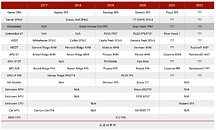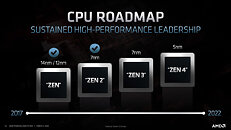- Joined
- Oct 9, 2007
- Messages
- 47,670 (7.43/day)
- Location
- Dublin, Ireland
| System Name | RBMK-1000 |
|---|---|
| Processor | AMD Ryzen 7 5700G |
| Motherboard | Gigabyte B550 AORUS Elite V2 |
| Cooling | DeepCool Gammax L240 V2 |
| Memory | 2x 16GB DDR4-3200 |
| Video Card(s) | Galax RTX 4070 Ti EX |
| Storage | Samsung 990 1TB |
| Display(s) | BenQ 1440p 60 Hz 27-inch |
| Case | Corsair Carbide 100R |
| Audio Device(s) | ASUS SupremeFX S1220A |
| Power Supply | Cooler Master MWE Gold 650W |
| Mouse | ASUS ROG Strix Impact |
| Keyboard | Gamdias Hermes E2 |
| Software | Windows 11 Pro |
Several future AMD processor codenames across various computing segments surfaced courtesy of an Expreview leak that's largely aligned with information from Komachi Ensaka. It does not account for "Matisse Refresh" that's allegedly coming out in June-July as three gaming-focused Ryzen socket AM4 desktop processors; but roadmap from 2H-2020 going up to 2022 sees many codenames surface. To begin with, the second half of 2020 promises to be as action packed as last year's 7/7 mega launch. Over in the graphics business, the company is expected to debut its DirectX 12 Ultimate-compliant RDNA2 client graphics, and its first CDNA architecture-based compute accelerators. Much of the processor launch cycle is based around the new "Zen 3" microarchitecture.
The server platform debuting in the second half of 2020 is codenamed "Genesis SP3." This will be the final processor architecture for the SP3-class enterprise sockets, as it has DDR4 and PCI-Express gen 4.0 I/O. The EPYC server processor is codenamed "Milan," and combines "Zen 3" chiplets along with an sIOD. EPYC Embedded (FP6 package) processors are codenamed "Grey Hawk."



The 4th generation Ryzen Threadripper HEDT processor family, which uses "Zen 3" chiplets, will be based on a package codenamed "Genesis Peak," and we predict it could retain compatibility with sTRX4 motherboards. AMD's main breadwinner for "Zen 3" is expected to be "Vermeer," which makes up the bulk of the 4th generation Ryzen desktop processor family in the AM4 package. These processors are compatible with socket AM4 motherboards based on AMD 400- and 500-series chipsets.
The "Zen 2" based "Renoir" silicon will power APUs slotted in the Ryzen 4000 product family, such as the Ryzen 7 4700G. AMD will also introduce an entry-level Athlon processor based on highly stripped down silicon codenamed "Dali." We're not sure what the underlying microarchitecture is. With the Athlon 3000G, for example, AMD tapped into the original "Zen" (Zen 1) microarchitecture.
2021 promises to be an equally big year for AMD, as it refreshes not just its EPYC server processor lineup, but also the underlying platform, with the introduction of the new SP5-series enterprise socket that has DDR5 memory interface. This platform is codenamed "Floyd," and the enterprise processor is codenamed "Genoa." The 4th generation EPYC "Genoa" processor introduces new 5 nm "Zen 4" CPU chiplets, and a brand new sIOD that supports DDR5 memory interface.
It is likely that AMD will introduce a new desktop socket, AM5. This will be necessitated with the DDR5 memory standard gaining market traction in 2021. The codename of the mainstream desktop processor, which immediately succeeds "Vermeer," is still unknown. We do know the name of the "Renoir" successor, "Cezanne," which will make its debut as a mobile FP6 part, but will end being the last major product launch on the AM4 socket, as a "Zen 3" based socket AM4 APU. So entry-thru-mainstream AM4-based options will be available just as AM5 takes up the performance-thru-enthusiast segments.
2022 is as far as the eye can see on AMD's near-term future, seeing the debut of the "Zen 5" microarchitecture that's already under development. Unless it's built on a refinement of a 5 nm-class process, it could debut 3 nm, as TSMC is expected to debut this process by late-2022. We don't know what codenames the SP5-based enterprise platform or the enterprise processor goes by, but we're hearing two new names. "Raphael" is the 2022 successor to the chip that succeeds "Vermeer" on the socket AM5 desktop platform and "Rembrandt" is likely to be the first socket AM5 APU, which will make its debut as a mobile processor before growing some pins.
View at TechPowerUp Main Site
The server platform debuting in the second half of 2020 is codenamed "Genesis SP3." This will be the final processor architecture for the SP3-class enterprise sockets, as it has DDR4 and PCI-Express gen 4.0 I/O. The EPYC server processor is codenamed "Milan," and combines "Zen 3" chiplets along with an sIOD. EPYC Embedded (FP6 package) processors are codenamed "Grey Hawk."



The 4th generation Ryzen Threadripper HEDT processor family, which uses "Zen 3" chiplets, will be based on a package codenamed "Genesis Peak," and we predict it could retain compatibility with sTRX4 motherboards. AMD's main breadwinner for "Zen 3" is expected to be "Vermeer," which makes up the bulk of the 4th generation Ryzen desktop processor family in the AM4 package. These processors are compatible with socket AM4 motherboards based on AMD 400- and 500-series chipsets.
The "Zen 2" based "Renoir" silicon will power APUs slotted in the Ryzen 4000 product family, such as the Ryzen 7 4700G. AMD will also introduce an entry-level Athlon processor based on highly stripped down silicon codenamed "Dali." We're not sure what the underlying microarchitecture is. With the Athlon 3000G, for example, AMD tapped into the original "Zen" (Zen 1) microarchitecture.
2021 promises to be an equally big year for AMD, as it refreshes not just its EPYC server processor lineup, but also the underlying platform, with the introduction of the new SP5-series enterprise socket that has DDR5 memory interface. This platform is codenamed "Floyd," and the enterprise processor is codenamed "Genoa." The 4th generation EPYC "Genoa" processor introduces new 5 nm "Zen 4" CPU chiplets, and a brand new sIOD that supports DDR5 memory interface.
It is likely that AMD will introduce a new desktop socket, AM5. This will be necessitated with the DDR5 memory standard gaining market traction in 2021. The codename of the mainstream desktop processor, which immediately succeeds "Vermeer," is still unknown. We do know the name of the "Renoir" successor, "Cezanne," which will make its debut as a mobile FP6 part, but will end being the last major product launch on the AM4 socket, as a "Zen 3" based socket AM4 APU. So entry-thru-mainstream AM4-based options will be available just as AM5 takes up the performance-thru-enthusiast segments.
2022 is as far as the eye can see on AMD's near-term future, seeing the debut of the "Zen 5" microarchitecture that's already under development. Unless it's built on a refinement of a 5 nm-class process, it could debut 3 nm, as TSMC is expected to debut this process by late-2022. We don't know what codenames the SP5-based enterprise platform or the enterprise processor goes by, but we're hearing two new names. "Raphael" is the 2022 successor to the chip that succeeds "Vermeer" on the socket AM5 desktop platform and "Rembrandt" is likely to be the first socket AM5 APU, which will make its debut as a mobile processor before growing some pins.
View at TechPowerUp Main Site







